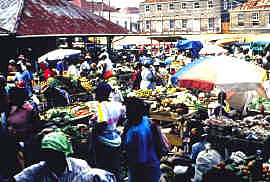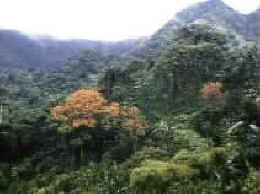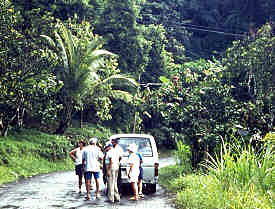GRENADA |
|
Harlan Hague |
| Americans know Grenada. They may not know
Palm Island, St. Lucia, Mayreau, or Sint Maarten, but they know Grenada. American forces invaded the island in the southern West Indies in 1983 and deposed a Marxist government. President Reagan justified the action on grounds that the United States would not tolerate the expansion of communism in the Caribbean and to protect American students at the St. George's University School of Medicine located on Grande Anse beach. When the subject came up recently during a taxi ride in St. George, the capital, my wife told the driver that many Americans were not proud of the invasion. "Why should they feel that way," he said. "We are very happy about it. President Reagan is a hero here." In fact, the day is commemorated with a national holiday, Thanksgiving Day, on October 25. |
| Yet, many Grenadians are hesitant to talk about it, perhaps because
of the American ambivalence. The leading guidebook devotes only a few scattered lines to
it and does not mention the role of the medical school at all. Little evidence remains of the "intervention," as locals term the conflict. A simple but moving monument on the campus of the medical school is dedicated to the nineteen American servicemen who lost their lives in the invasion. It is a unique monument, displaying the signatures of those who died. Grenada was born in conflict. Like other islands of the West Indies, it was fought over by native Arawaks and Caribs, then by Caribs and French, finally by French and British. The British prevailed in the mid-eighteenth century, but French residents were not content. They were particularly upset by what they perceived as persecution of the Catholic church. Taking their lead from the French Revolution, French Grenadians staged a bloody rebellion in 1795. The defeat of the rebels is still commemorated each year. Today Grenada is a completely independent democratic republic, a member of the British Commonwealth, which recognizes the British monarch as the Head of State. The queen is represented in the island by a Governor-General. Grenada today is tranquil and inviting. The circular deepwater harbor at St. George's, called the Carenage, is one of the loveliest in the West Indies. Shops line the waterfront, and houses cling to the green hillsides. Stalls of spice sellers line the roadway near the wharf, and the haunting sound of the conch shell announces the arrival of a fresh catch of fish. The best place to view the Carenage is at a window table on the second-floor Nutmeg restaurant. If you are there at mealtime, try lambie, which is not young sheep, by the way. It is the local name for conch. The restaurant's name is indicative of the island's fame as the Isle of Spice. Tourism is important to the island's economy--Grenadians call Columbus their "first cruise visitor"--but, unlike most other Caribbean islands, agriculture is more important. Principal exports are cocoa, nutmegs, and bananas. The nutmeg is so important that it is featured on the Grenadian flag. Other crops include sugar cane, bamboo, coconuts, limes, cloves, cinnamon, mangos, avocados, and breadfruit. Vegetables are grown for local consumption. The bounty of the land is best seen over the hill from the harbor at Market Square,
once a place of When my wife replied to a seller's overture by saying that she had already bought spices, the woman said, "That's all right, dear, enjoy our beautiful island." We stopped and, in response to our question, she explained how mace, the red lacy covering of the nutmeg, is harvested. For the best panoramic view of the market, and the best place for pictures, go up on the porch of the brick building at the top of the square. One of the most interesting streets in the town, Church Street, is just a block from Market Square. The Roman Catholic cathedral stands at the top. Originally serving the French population when it was built in the early nineteenth century, it contains some interesting statues and stained glass. Walking down the street, visit York House. Dating from the late eighteenth century, it houses the Parliament and the Supreme Court. Farther down Church Street, the Anglican church, built in 1825, has some pretty stained glass windows and memorial plaques to those loyal Grenadians who died in the French rebellion in 1795. The clock in the square bell tower strikes the Westminster chimes. At the bottom of the hill, look up to the right to St. Andrew's, a Presbyterian church, known locally as the Scots Kirk, built in 1831. There is a nice view of the coast from the church lawn. Walk over the hill toward the harbor, and visit the Grenada National Museum. The building, constructed in 1704 as a French military barracks, houses artifacts from aboriginal sites and traces development of the island following European occupation. The implements of the sugar cane industry are particularly interesting. Caveat: If you walk through Sendall Tunnel which pierces the ridge between the bay and the market, hug the wall and keep your elbows in. The eighteenth-century tunnel is wide enough for one car with about two feet to spare on each side. The best bet is to avoid the tunnel and walk over the hill. Spend at least a day exploring the countryside. The best way to see it is by taxi. The principal taxi stands are on the esplanade near Market Square and at the pier. The tourist bureau at the pier will help with taxi arrangements, in fact with any assistance you might need. Before leaving, reach an understanding on what you will see, and agree on a price. The going rate is $l5-20 per hour for the taxi, not per person. Grenadian taxi drivers are generally good guides.
The drive inland from St. George's to Grand Etang Forest Reserve is most rewarding. The
road passes nutmeg trees, groves of bananas and cacao, and Overlooking the deep Grand Etang Lake, which lies in the crater of an extinct volcano, the headquarters building of the Forestry Department houses an interpretation center. A number of hiking trails begin at the center. Guides are often available at the center, but it would be wise to inquire at the tourist office in St. George's if you would like to walk with a guide. Wherever your day ends, treat yourself to a rum punch, the island's best refresher.
It's available The best guide for tourists is Grenada: Isle of Spice, by Norma Sinclair. For information on accommodations and attractions, write to Grenada Tourism Office, 820 2nd Avenue, Suite 900D, New York, NY 10017, telephone (212) 687-9554. |
|
Caveat and disclaimer: This is a freelance travel article that I published some time ago. Some data, especially prices, links and contact information, may not be current. |
|
|
|
|
 execution. Every day except Sunday, vendors display
their fruits and vegetables in the open square. The stalls of spice sellers line the
walkways of a covered market. The aromas are heavenly. Don't hesitate to stop and talk.
Like Grenadians in general, vendors are friendly, and not at all aggressive. Ask about
spices and foods that are not familiar.
execution. Every day except Sunday, vendors display
their fruits and vegetables in the open square. The stalls of spice sellers line the
walkways of a covered market. The aromas are heavenly. Don't hesitate to stop and talk.
Like Grenadians in general, vendors are friendly, and not at all aggressive. Ask about
spices and foods that are not familiar.  A circular drive rings the island, and roads lead into the
interior of mountains and lush rain forest. Beautiful uncrowded beaches tempt one to
abandon all plans and simply stay. The white sands of two-mile long Grande Anse Beach is
just south of St. George's. The powdery volcanic black sands at Black Bay, a few miles
north of St. George's, are also inviting. Snorkeling is particularly good over the coral
formations on the west coast. Scuba diving is popular over the wreck of the liner Bianca
C, at a depth of 100'.
A circular drive rings the island, and roads lead into the
interior of mountains and lush rain forest. Beautiful uncrowded beaches tempt one to
abandon all plans and simply stay. The white sands of two-mile long Grande Anse Beach is
just south of St. George's. The powdery volcanic black sands at Black Bay, a few miles
north of St. George's, are also inviting. Snorkeling is particularly good over the coral
formations on the west coast. Scuba diving is popular over the wreck of the liner Bianca
C, at a depth of 100'.  green hillsides of ferns, native trees, and fir and teak trees. The latter were planted
after hurricane Janet in 1955 virtually denuded the area. Surprisingly, Janet is the only
hurricane known to have struck the island since records have been kept.
green hillsides of ferns, native trees, and fir and teak trees. The latter were planted
after hurricane Janet in 1955 virtually denuded the area. Surprisingly, Janet is the only
hurricane known to have struck the island since records have been kept.  everywhere, or mix it yourself. The Grenadian recipe: take one of
sour, two of sweet, three of strong, four of weak. Meaning lime juice, syrup, rum, and
water. Stir, pour over ice, and top with a sprinkling of grated nutmeg. That's West
Indian, mon.
everywhere, or mix it yourself. The Grenadian recipe: take one of
sour, two of sweet, three of strong, four of weak. Meaning lime juice, syrup, rum, and
water. Stir, pour over ice, and top with a sprinkling of grated nutmeg. That's West
Indian, mon.